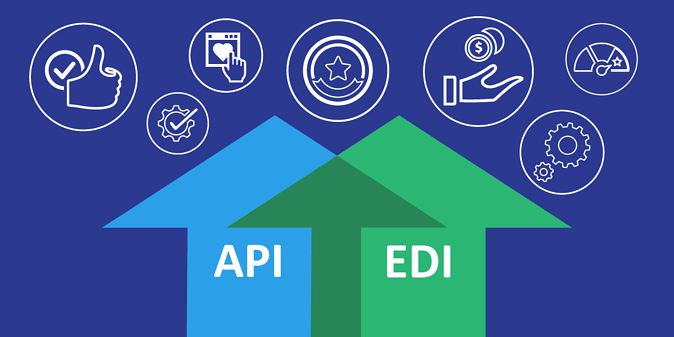The Need for Modern B2B Integration Tools
Organizations need modern B2B integration capabilities for speed, agility, and innovation. Yet too many still use outdated approaches to EDI and B2B integration. They continue to rely on legacy B2B integration tools that can’t help them overcome the many challenges they face, such as:
- A Rise in Cybersecurity Attacks — A recent report by SonicWall says that in 2021, ransomware attacks increased 105% YoY, and encrypted threats rose 167% YoY. Legacy B2B integration software is far more vulnerable to security attacks than modern integration solutions. And once bad actors breach your systems, they can remain hidden for months, stealing sensitive information and wreaking havoc on your business.
- A Rapidly Complex and Growing B2B Network — You need to connect with all your trading partners so that you can exchange the documents and information required to process transactions. That network gets more extensive and complex with every new trading partner. Most organizations exchange data with more than 250 partners, suppliers, and customers.
- Partners Don’t Understand Every Format — Businesses today must deal with a staggering number of different formats — from EDI, APIs, B2B software, and data sources. One partner might want to integrate APIs that return JSON or XML responses, while another might prefer to exchange documents with an EDI format like X12 or EDIFACT. You’re bound to run into partners who can’t understand some of your company’s formats. So, you often spend time figuring out how to import and export information from partner systems.
- Massive Volumes of B2B and EDI Transactions — Many companies, especially retail, must deal with a massive volume of B2B and EDI transactions. Think about companies with thousands of trading partners, like Walmart, Amazon, and Costco. These companies process millions of transactions and document exchanges every day. Managing so many transactions and exchanges of data becomes more challenging as volumes increase.
You need modern EDI and B2B integration tools. Legacy tools have drawbacks and limitations that make it impossible to overcome these challenges.
Drawbacks of Using Legacy B2B and EDI Integration Tools
Legacy B2B and EDI integration tools come with many drawbacks, such as:
- Limited in Format Support and Scale — Legacy B2B integration solutions don’t support the growing volume and variety of B2B transactions. You can try to create workarounds, but legacy tools weren’t designed for modern applications and transactions, nor the staggering volume of transactions we see today.
- Exposure to Security Threats and Vulnerabilities — Many legacy integration tools receive ineffective security updates or no longer receive any security updates. IT departments must develop their own solutions to ensure the security of their systems. These in-house security solutions often can’t detect new and emerging security threats.
- Not Always Connected or In Real Time — Legacy EDI and B2B integration software typically process data in batches and weren’t designed for real-time data exchanges. An increasing number of transactions must be completed in real-time, like eCommerce orders and shipping updates. And for partner systems to work together, they must always stay connected.
- Time-Consuming Partner Onboarding — One study found that 40% of enterprises take more than 30 days to onboard a new trading partner. It takes a long time to onboard partners because of the complexity and non-user-friendly nature of legacy software. Also, older integration software systems tend to involve many manual processes, so you get complicated and time-consuming partner onboarding.
- Not Designed for the Cloud — For many companies, legacy EDI and B2B integration software were put in place when hardware and software were almost entirely on-premises. You need the cloud if you want your business to survive in today’s digital world. Legacy integration software doesn’t work well with the cloud because it wasn’t designed for it.
- Lack of Visibility and Tracking — Many companies today struggle with visibility, especially those in the supply chain. Legacy integration software offers basic analytics tools, but it cannot monitor complex systems or provide deep insights. Legacy integration tools can’t provide visibility into the entire API lifecycle or transactions in real-time.
If you still use legacy B2B and EDI integration solutions, you need to consider a new approach to B2B integration and modern tools.
Why Modernize Your B2B and EDI Integration Capabilities?
Because modernization will help you overcome the challenges described above and get past the limitations of legacy B2B and EDI integration solutions. Modernizing B2B integration allows you to:
- Connect to More Partners and Expand Your Capabilities — When you modernize your EDI and B2B integration capabilities, you ensure many more partners can connect with your systems. A modern integration solution supports sending and receiving data using any protocol or communications standard. Partners can use the formats they prefer, such as EDIFACT, FTP, and HTTPS. It also supports connections to your internal systems or integration layer, which could include SAP or Salesforce. So, you can easily onboard more partners, which means you have more capabilities available through your network.
- Implement Better Security — You can significantly improve the security of your existing B2B and EDI integrations by incorporating modern integration solutions. A current integration solution can act as a barrier between modern technologies like APIs and your legacy systems. You get better security tools like access security (SSO, 2FA) and encrypted data transfers. You can also take advantage of automated security alerts.
- Enable Scalable, Always-On Connectivity — Your supply chain depends on the reliable exchange of documents and processing of transactions. A modern B2B integration solution ensures that you always have secure connections with trading partners. Always-on connectivity helps with automating B2B processes with partners and securing the movement of data between systems.
- Simplify and Speed Up Partner Onboarding — We live in an instant-gratification society — your trading partners don’t want to wait 30 days or more to get started with your network. Modern B2B integration solutions allow you to speed up partner onboarding from weeks to hours or minutes. For example, IBM Sterling Supply Chain Business Network includes preconnected trading partners, speeding up onboarding for partners in the network. Onboarding can go even faster if you incorporate our B2B Framework for IBM Sterling B2B Integrator.
- Ensure All Integrations are Cloud Friendly — Today, most businesses operate in the cloud to some degree because cloud-friendly design patterns bring many benefits. Modernizing your B2B and EDI integrations with cloud solutions will ensure that they will work with cloud applications and services. Most B2B integration solutions today are designed for the cloud or include cloud-friendly components. For example, IBM App Connect includes a vast library of connectors, making it easy to integrate with popular cloud services and platforms.
- Gain Better Visibility into Transactions — You need deep visibility into transactions to build trust between you and your partners. You also need visibility into your B2B and EDI integrations to ensure that the information flows remain seamless and error-free. Modern integration tools allow everyone in your B2B ecosystem to see into the lifecycle of every transaction and drill down to get the granular information they need. You can gain deep visibility and insights across all your critical systems with the Eliassen Group Visibility Portal.
Don’t Wait to Modernize Your B2B and EDI Integration Capabilities
When you modernize your B2B and EDI integration capabilities, you can do many things faster, like process transactions, get products to market, and deploy integrations. You can pivot quickly when the market, consumers, or partner requirements suddenly change. And you can enable innovation in your integrations using cutting-edge technologies. You shouldn’t wait to modernize your capabilities — take steps to change your approach to B2B and EDI integration now.
Where does your company stand on modernizing B2B integration?
Complete our B2B Integration Modernization Assessment to assess your B2B and EDI maturity.
Also, check out the next article in this series, where we explain how to modernize your approach to B2B and EDI integration.



